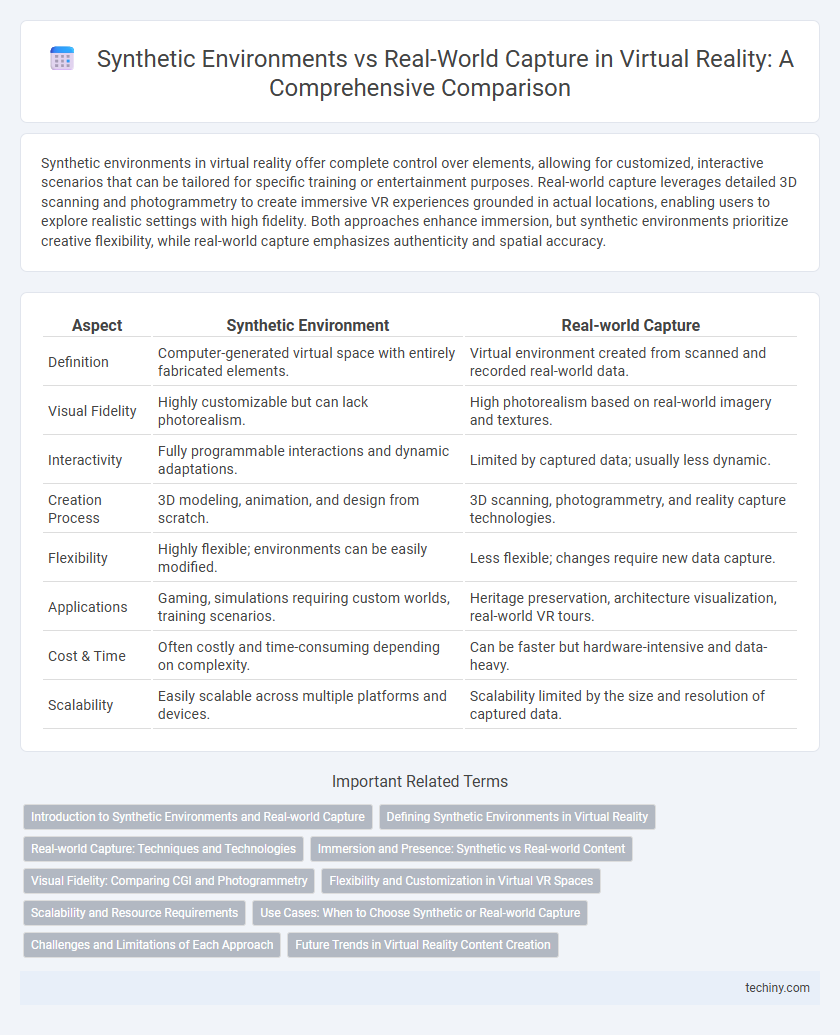Synthetic environments in virtual reality offer complete control over elements, allowing for customized, interactive scenarios that can be tailored for specific training or entertainment purposes. Real-world capture leverages detailed 3D scanning and photogrammetry to create immersive VR experiences grounded in actual locations, enabling users to explore realistic settings with high fidelity. Both approaches enhance immersion, but synthetic environments prioritize creative flexibility, while real-world capture emphasizes authenticity and spatial accuracy.
Table of Comparison
| Aspect | Synthetic Environment | Real-world Capture |
|---|---|---|
| Definition | Computer-generated virtual space with entirely fabricated elements. | Virtual environment created from scanned and recorded real-world data. |
| Visual Fidelity | Highly customizable but can lack photorealism. | High photorealism based on real-world imagery and textures. |
| Interactivity | Fully programmable interactions and dynamic adaptations. | Limited by captured data; usually less dynamic. |
| Creation Process | 3D modeling, animation, and design from scratch. | 3D scanning, photogrammetry, and reality capture technologies. |
| Flexibility | Highly flexible; environments can be easily modified. | Less flexible; changes require new data capture. |
| Applications | Gaming, simulations requiring custom worlds, training scenarios. | Heritage preservation, architecture visualization, real-world VR tours. |
| Cost & Time | Often costly and time-consuming depending on complexity. | Can be faster but hardware-intensive and data-heavy. |
| Scalability | Easily scalable across multiple platforms and devices. | Scalability limited by the size and resolution of captured data. |
Introduction to Synthetic Environments and Real-world Capture
Synthetic environments are computer-generated simulations that create immersive, interactive virtual worlds using 3D modeling, animation, and physics engines to replicate real or imagined settings. Real-world capture involves using technologies like photogrammetry, LiDAR scanning, and 360-degree video to digitize physical spaces for accurate representation in virtual reality. Both methods enhance VR experiences by offering distinct advantages: synthetic environments allow unlimited creative control, while real-world capture delivers high-fidelity realism.
Defining Synthetic Environments in Virtual Reality
Synthetic environments in virtual reality are computer-generated, immersive worlds created using 3D modeling and simulation technologies to replicate real or imagined settings with precise control over variables and interactions. These environments offer dynamic, customizable experiences that can be tailored for training, entertainment, or research, contrasting with real-world capture, which relies on photogrammetry or 360-degree video to reproduce existing physical spaces. Synthetic environments provide enhanced flexibility and scalability, enabling users to explore scenarios impossible or impractical in the real world.
Real-world Capture: Techniques and Technologies
Real-world capture in virtual reality relies on advanced techniques such as photogrammetry, LiDAR scanning, and 360-degree video to create highly accurate digital replicas of physical environments. These technologies enable immersive experiences by preserving intricate details, textures, and spatial relationships from real locations, enhancing realism and user engagement. Integration of AI-driven processing further refines captured data, optimizing rendering speeds and visual fidelity for seamless VR interaction.
Immersion and Presence: Synthetic vs Real-world Content
Synthetic environments in virtual reality offer unparalleled control over immersion by enabling fully customizable and interactive experiences that adapt dynamically to user input. Real-world capture leverages photogrammetry and 360-degree video to deliver highly realistic visuals, enhancing presence through authentic environmental cues and spatial audio. The balance between synthetic content's flexibility and real-world content's authenticity defines the level of user engagement and perceived presence in VR applications.
Visual Fidelity: Comparing CGI and Photogrammetry
Synthetic environments leverage CGI to create highly customizable visuals with precise control over textures and lighting, enabling complex scene manipulations beyond physical limitations. Real-world capture via photogrammetry offers unmatched photorealism by reconstructing detailed, true-to-life textures and geometric accuracy directly from real scenes. Visual fidelity in synthetic environments benefits from artistic flexibility, while photogrammetry excels in authentic representation, driving diverse applications in VR depending on the need for realism or creative control.
Flexibility and Customization in Virtual VR Spaces
Synthetic environments in virtual reality offer unparalleled flexibility and customization, allowing users to design and manipulate immersive spaces tailored to specific needs or scenarios. Unlike real-world capture, which relies on fixed, pre-existing data, synthetic environments enable dynamic modifications, enhancing interactivity and personalization. This adaptability makes synthetic VR spaces ideal for training, simulation, and creative applications requiring precise control over environmental variables.
Scalability and Resource Requirements
Synthetic environments in virtual reality offer superior scalability by enabling infinite modifications and expansions without the need for physical alterations, significantly reducing resource consumption compared to real-world capture methods. Real-world capture relies heavily on extensive hardware, high-resolution sensors, and meticulous post-processing, making it resource-intensive and less flexible for large-scale applications. Efficient synthetic environment creation leverages algorithmic generation and procedural modeling, optimizing computational resources and enabling rapid deployment across various VR scenarios.
Use Cases: When to Choose Synthetic or Real-world Capture
Synthetic environments excel in training simulations and architectural visualization where complete control over variables and scalability is essential. Real-world capture is preferred for heritage preservation and immersive storytelling to achieve high fidelity and authentic detail. Choosing between the two depends on the need for flexibility versus accuracy in the VR experience.
Challenges and Limitations of Each Approach
Synthetic environments in virtual reality offer complete control over content creation but face challenges in achieving photorealistic detail and natural physics, often requiring significant computational resources. Real-world capture, while providing authentic visuals through photogrammetry or LiDAR scanning, is limited by data resolution constraints, environmental variability, and the complexity of dynamic scene reconstruction. Both approaches struggle with real-time rendering performance and scalability, affecting immersion and user experience in VR applications.
Future Trends in Virtual Reality Content Creation
Synthetic environments in virtual reality are evolving with AI-driven procedural generation, enabling highly customizable and immersive worlds that adapt in real-time to user interactions. Real-world capture technology, leveraging advanced photogrammetry and LiDAR scanning, continues to improve in accuracy and scalability, allowing seamless integration of authentic environments into VR experiences. Future trends emphasize hybrid approaches combining synthetic generation with real-world data to produce richer, more dynamic virtual content tailored for diverse applications such as training, gaming, and remote collaboration.
Synthetic Environment vs Real-world Capture Infographic

 techiny.com
techiny.com